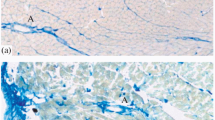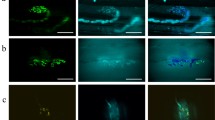Summary
The chromatophore muscle cells of Loligo vulgaris consist of a marginal zone of apparently helically arranged myofibrils, surrounded by sarcoplasm and a central hyalinous core. Each muscle element is covered by a connective tissue sheath. In the distal part of the muscle cell the marginal zone shows a wing-shaped protrusion; at the cell basis a narrow gap is visible, establishing a close connection between the sarcoplasm and the central core of the muscle, cell. — By means of silver impregnation a multiple innervation of the chromatophores has been shown. The fibers form a synaptic contact with the sarcoplasm and follow the muscle cell in a centripetal, occasionally even in a centrifugal direction. At the cell basis nervous structures penetrate through the gap of the marginal zone and may be followed to the vicinity of the pigment cell. Within the core of the muscle another nerve fiber can be distinguished and followed up to the region of the nucleus. Questions concerning a possible variability in the mode of innervation of different chromatophores and functional aspects are briefly discussed.
Zusammenfassung
Die Chromatophorenmuskelzellen von Loligo vulgaris bestehen aus einer äußeren, von Sarcoplasma umgebenen Schicht scheinbar spiralig gewundener Myofibrillen und einem zentralen, hyalin erscheinenden Innenraum. Jede Muskelzelle wird von Bindegewebe umhüllt. Im distalen Abschnitt der Muskelzelle ist die kontraktile Randzone mit flügelartigen Fortsätzen versehen. An der Zellbasis öffnet sie sich zu einem schmalen Spalt, dadurch wird eine direkte Verbindung zwischen dem Sarcoplasma und dem zentralen Strang des Muskels hergegestellt. — Mittels Silberimprägnation wird eine multiple Innervation von Chromatophoren nachgewiesen. Die Pasern treten in synaptischen Kontakt mit dem Sarcoplasma und folgen der Muskelzelle in zentripetaler, gelegentlich auch in zentrifugaler Richtung. An der Zellbasis dringen Nervenfasern durch den Spalt der Randzone in das Innere des Muskels und weiter bis in die Nähe der Pigmentzelle vor. Innerhalb des Zentralstranges läßt sich eine weitere Nervenfaser darstellen und bis zur Kernregion verfolgen. Fragen einer möglichen Variabilität des Innervationsmodus der verschiedenen Chromatophoren sowie funktioneile Gesichtspunkte werden kurz diskutiert.
Similar content being viewed by others
Literatur
Bowden, J.: The structure and innervation of lamellibranch muscle. In: International revue of cytology (G.H. Bourne and J.F. Danielli, eds.) vol. VII, p. 295–336. New York: Academic Press 1958.
Boycott, B. B.: The chromatophore system of cephalopods. Proc. Linnean Soc. London 164, 235–240 (1953).
Bozler, E.: Über die Tätigkeit der einzelnen glatten Muskelfaser bei der Kontraktion. II. Mitt.: Die Chromatophorenmuskeln der Cephalopoden. Z. vergl. Physiol. 27, 379–406 (1928a).
—: Über die Tätigkeit der einzelnen glatten Muskelfaser bei der Kontraktion. 3. Mitt.: Registrierung der Kontraktionen der Chromatophorenmuskelzellen von Cephalopoden. Z. vergl. Physiol. 13, 762–772 (1931).
—: Über die Frage des Tonussubstrates. Z. vergl. Physiol. 7, 407–435 (1928b).
Cate, J. ten: Contribution à la question de l'innervation des chromatophores chez Octopus vulgaris. Arch. néerl. sci., Sér. IIIC 12, 668–699 (1928).
Cloney, R., and E. Florey: Ultrastructure of cephalopod chromatophore organs. Z. Zellforsch. 89, 250–280 (1968).
Florey, E.: Nervous control and spontaneous activity of the chromatophores of a cephalopod, Loligo opalescens. Comp. Biochem. Physiol. 18, 305–324 (1966).
Fuchs, R. F.: Der Farbwechsel und die chromatische Hautfunktion der Tiere. In: Handbuch der vergleichenden Physiologie (H. Winterstein ed.), Bd. 3, 1. Hälfte, S. 1189–1656, 1914.
Hanson, J., and J. Lowy: Structure and function of the contractile apparatus in the muscles of invertebrate animals. In: Structure and function of muscle (G. H. Bourne ed). New York and London: Academic Press 1960.
Hofmann, F. B.: Histologische Untersuchungen über die Innervation der glatten und der ihr verwandten Muskulatur der Wirbeltiere und der Mollusken. Arch. mikr. Anat. 70, 361–413 (1907).
Kühn, A., u. R. F. Heberdey: Über die Anpassung von Sepia officinalis L. an Helligkeit und Farbton der Umgebung. Verh. dtsch. zool. Ges. 4, 231–237 (1929).
Nicol, J. A. C.: Special effectors: Luminous organs, chromatophores, pigments and poison glands. In: Physiology of mollusca (K. M. Wilbour and C. M. Yonge, eds.) New York and London: Academic Press 1964.
Palmgren, A.: A rapid method for selective silver staining of nerve fibers and nerve endings in mounted paraffin sections. Acta zool. (Stockh.) 29, 377–392 (1948).
Parker, G. H.: Animal colour changes and their neurohumors. A survey of investigations 1910–1943. London and New York: Cambridge University Press 1948.
Rowell, C. H. F.: Excitatory and inhibitory pathways in the arm of Octopus. J. exp. Biol. 40, 257–270 (1963).
Sereni, E.: Sui cromatofori dei cephalopodi. Z. vergl. Physiol. 8, 488–600 (1929).
Weber, W.: Mehrfachinnervation von Tintenfisch-Chromatophoren. Naturwissenschaften 55, 348–349 (1968).
Author information
Authors and Affiliations
Additional information
Mit Unterstützung durch die Deutsche Forschungsgemeinschaft.
Zur weiteren Aufklärung der hier angedeuteten morphologischen und physiologischen Probleme sind Untersuchungen im Gange.
Rights and permissions
About this article
Cite this article
Weber, W. Multiple Innervation der Chromatophorenmuskelzellen von Loligo vulgaris . Z.Zellforsch 92, 367–376 (1968). https://doi.org/10.1007/BF00455593
Received:
Issue Date:
DOI: https://doi.org/10.1007/BF00455593




